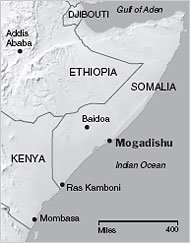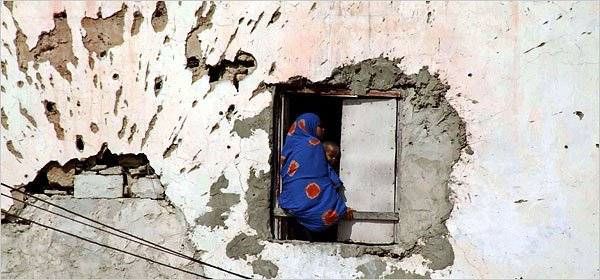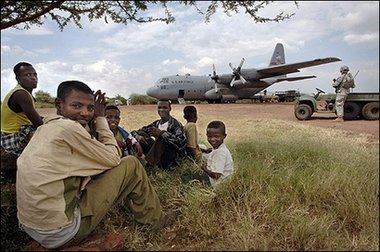
Government troops in
Baidoa, Somalia, where the United States reportedly
helped Ethiopia battle Islamist forces.
U.S. routed Islamic militants from EthiopiaWASHINGTON: The U.S. military quietly waged a campaign from Ethiopia last month to capture or kill top leaders of Al Qaeda in the Horn of Africa, including the use of an airstrip in eastern Ethiopia to mount airstrikes against Islamic militants in neighboring Somalia, according to U.S. officials. The close and largely clandestine relationship with Ethiopia also included significant sharing of intelligence on the Islamic militants' positions and information from U.S. spy satellites with the Ethiopian military. Members of a secret U.S. Special Operations unit, Task Force 88, were deployed in Ethiopia and Kenya, and ventured into Somalia, the officials said. The counterterrorism effort was described by U.S. officials as a qualified success that disrupted terrorist networks in the East African nation, led to the death and capture of several Islamic militants and involved a collaborative relationship with Ethiopia that had been developing for years. But the tally of the dead and captured does not as yet include some Qaeda leaders, including Fazul Abdullah Muhammad and Fahid Muhammad Ally Msalam, whom the United States has hunted for their suspected roles in the attacks on U.S. embassies in Kenya and Tanzania in 1998. [An Ethiopian official denied Friday that U.S. troops used Ethiopia as a staging ground for attacks against Qaeda leaders, The Associated Press reported from Mogadishu, Somalia. ["This is simply a total fabrication," said the official, Bereket Simon, adviser to Prime Minister Meles Zenawi.] With Somalia still in a chaotic state, and U.S. and African officials struggling to cobble together a peacekeeping force for the war-ravaged country, the long-term effects of the recent U.S. operations remain unclear. It has been known for several weeks that U.S. Special Operations troops have operated inside Somalia and that the United States carried out two strikes on Qaeda suspects using AC-130 gunships. But the extent of U.S. cooperation with the recent Ethiopian invasion into Somalia and the fact that the Pentagon secretly used an airstrip in Ethiopia to carry out attacks have not been previously reported. The secret campaign in the Horn of Africa is an example of a more aggressive approach the Pentagon has taken in recent years to dispatch Special Operations troops globally to hunt high-level terrorism suspects. After the attacks on Sept. 11, 2001, President George W. Bush gave the Pentagon the authority to carry out these missions, which historically had been reserved for intelligence operatives. When Ethiopian troops first began a large-scale military offensive in Somalia late last year, officials in Washington denied that the Bush administration had given its tacit approval to the Ethiopian government. In interviews over the past several weeks, however, officials from several U.S. agencies with a hand in Somalia policy have described a close alliance between Washington and the Ethiopian government that was developed with a common purpose: rooting out Islamic radicalism inside Somalia.
Bryan Whitman, a Pentagon spokesman, declined to discuss details of the U.S. operation, but some officials agreed to provide specifics because they saw it as a relative success story. They said that the close relationship had included the sharing of battlefield intelligence on the Islamists' positions — the result of an Ethiopian request to General John Abizaid, then the head of the U.S. Central Command. John Negroponte, the director of national intelligence at the time, then authorized spy satellites to be diverted to provide information for Ethiopian troops, the officials said. The deepening U.S. alliance with Ethiopia is the latest twist in the United States' on-and-off intervention in Somalia, beginning with an effort in 1992 to distribute food to starving Somalis and evolving into a deadly confrontation in 1993 between U.S. troops and fighters loyal to a Somali warlord, Muhammad Farah Aidid. The latest chapter began last June when the Council of Islamic Courts, an armed fundamentalist movement, defeated a coalition of warlords backed by the CIA and took power in Mogadishu, the capital. The Islamists were believed to be sheltering Qaeda militants involved in the embassy bombings, as well as in a 2002 hotel bombing in Kenya. After a failed CIA effort to arm and finance Somali warlords, the Bush administration decided on a policy to bolster Somalia's weak transitional government. This decision brought U.S. policy in line with Ethiopia's. As the Islamists' grip on power grew stronger, their militias began to encircle Baidoa, where the transitional government was operating in virtual exile. Ethiopian officials pledged that if the Islamists attacked Baidoa, they would respond with a full-scale assault.  While Washington
resisted officially endorsing an Ethiopian
invasion, U.S. officials from several
government agencies said that the Bush
administration decided last year that an
incursion was the best option to dislodge
the Islamists. While Washington
resisted officially endorsing an Ethiopian
invasion, U.S. officials from several
government agencies said that the Bush
administration decided last year that an
incursion was the best option to dislodge
the Islamists.When the Ethiopian offensive began on Dec. 24, it soon turned into a rout, somewhat to the Americans' surprise. Armed with U.S. intelligence, the Ethiopians' tank columns, artillery batteries and military jets made quick work of the ill-equipped Islamist militia. As the Islamists retreated, the Qaeda operatives and their close aides fled south toward a swampy region. Using information provided by Ethiopian forces in Somalia as well as U.S. intelligence, a task force from the Pentagon's Joint Special Operations Command began planning direct strikes. On Dec. 31, the largely impotent transitional government of Somalia submitted a formal request to the U.S. ambassador in Kenya asking for the United States to take action against the militants. Abizaid called Defense Secretary Robert Gates and told him that the Central Command was sending additional Special Operations Forces to the region. The deployment was carried out under the terms of an earlier, classified directive that gave the military the authority to kill or capture senior Qaeda operatives if it was determined that the failure to act expeditiously meant the United States would lose a "fleeting opportunity" to neutralize the enemy, U.S. officials said. On Jan. 6, two air force AC-130 gunships, aircraft with devastating firepower, arrived at a small airport in eastern Ethiopia. U.S. Special Operations troops operating in Kenya, working with the Kenyan military, also set up positions along the southern border to capture militants trying to flee the country. Off the coast, a U.S. Navy flotilla began to search for ships that might be carrying fleeing Qaeda operatives. Jeffrey Gettleman contributed reporting from Nairobi. Source:
http://www.iht.com/articles/2007/02/23/news/somalia.php
Ethiopia Denies U.S.
Troops Staged Somalia Attacks From its Territory
ADDIS ABABA, Ethiopia — An Ethiopian
official denied Friday a report in the New York Times that
U.S. troops used Ethiopia as a staging ground for attacks
against Al Qaeda leaders in Somalia last month. |
 The Pentagon has been training
Ethiopian troops for counterterrorism operations for several
years in camps near the Somali border, including Ethiopian
special forces called the Agazi Commandos, which were part
of the Ethiopian offensive in Somalia.
The Pentagon has been training
Ethiopian troops for counterterrorism operations for several
years in camps near the Somali border, including Ethiopian
special forces called the Agazi Commandos, which were part
of the Ethiopian offensive in Somalia.
